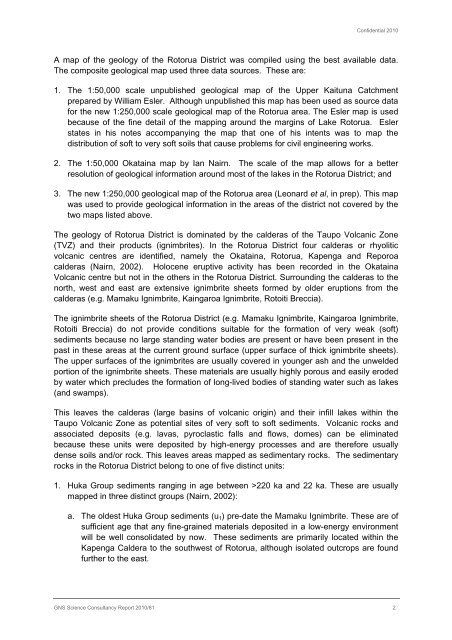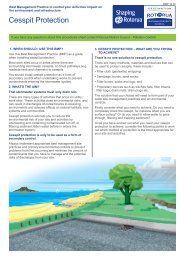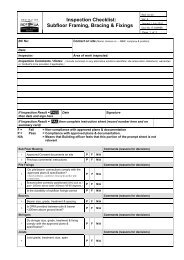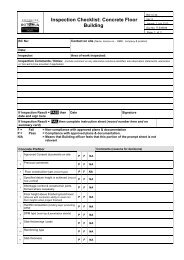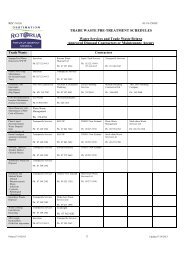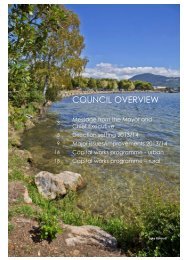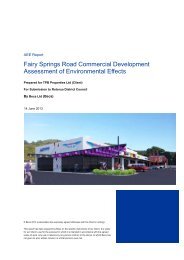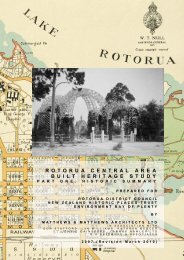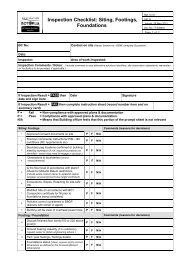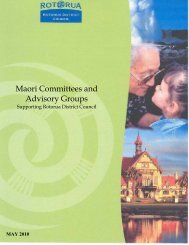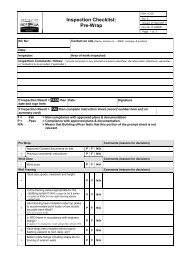Soft Soil Hazard Report - Rotorua District Council
Soft Soil Hazard Report - Rotorua District Council
Soft Soil Hazard Report - Rotorua District Council
Create successful ePaper yourself
Turn your PDF publications into a flip-book with our unique Google optimized e-Paper software.
Confidential 2010<br />
A map of the geology of the <strong>Rotorua</strong> <strong>District</strong> was compiled using the best available data.<br />
The composite geological map used three data sources. These are:<br />
1. The 1:50,000 scale unpublished geological map of the Upper Kaituna Catchment<br />
prepared by William Esler. Although unpublished this map has been used as source data<br />
for the new 1:250,000 scale geological map of the <strong>Rotorua</strong> area. The Esler map is used<br />
because of the fine detail of the mapping around the margins of Lake <strong>Rotorua</strong>. Esler<br />
states in his notes accompanying the map that one of his intents was to map the<br />
distribution of soft to very soft soils that cause problems for civil engineering works.<br />
2. The 1:50,000 Okataina map by Ian Nairn. The scale of the map allows for a better<br />
resolution of geological information around most of the lakes in the <strong>Rotorua</strong> <strong>District</strong>; and<br />
3. The new 1:250,000 geological map of the <strong>Rotorua</strong> area (Leonard et al, in prep). This map<br />
was used to provide geological information in the areas of the district not covered by the<br />
two maps listed above.<br />
The geology of <strong>Rotorua</strong> <strong>District</strong> is dominated by the calderas of the Taupo Volcanic Zone<br />
(TVZ) and their products (ignimbrites). In the <strong>Rotorua</strong> <strong>District</strong> four calderas or rhyolitic<br />
volcanic centres are identified, namely the Okataina, <strong>Rotorua</strong>, Kapenga and Reporoa<br />
calderas (Nairn, 2002). Holocene eruptive activity has been recorded in the Okataina<br />
Volcanic centre but not in the others in the <strong>Rotorua</strong> <strong>District</strong>. Surrounding the calderas to the<br />
north, west and east are extensive ignimbrite sheets formed by older eruptions from the<br />
calderas (e.g. Mamaku Ignimbrite, Kaingaroa Ignimbrite, Rotoiti Breccia).<br />
The ignimbrite sheets of the <strong>Rotorua</strong> <strong>District</strong> (e.g. Mamaku Ignimbrite, Kaingaroa Ignimbrite,<br />
Rotoiti Breccia) do not provide conditions suitable for the formation of very weak (soft)<br />
sediments because no large standing water bodies are present or have been present in the<br />
past in these areas at the current ground surface (upper surface of thick ignimbrite sheets).<br />
The upper surfaces of the ignimbrites are usually covered in younger ash and the unwelded<br />
portion of the ignimbrite sheets. These materials are usually highly porous and easily eroded<br />
by water which precludes the formation of long-lived bodies of standing water such as lakes<br />
(and swamps).<br />
This leaves the calderas (large basins of volcanic origin) and their infill lakes within the<br />
Taupo Volcanic Zone as potential sites of very soft to soft sediments. Volcanic rocks and<br />
associated deposits (e.g. lavas, pyroclastic falls and flows, domes) can be eliminated<br />
because these units were deposited by high-energy processes and are therefore usually<br />
dense soils and/or rock. This leaves areas mapped as sedimentary rocks. The sedimentary<br />
rocks in the <strong>Rotorua</strong> <strong>District</strong> belong to one of five distinct units:<br />
1. Huka Group sediments ranging in age between >220 ka and 22 ka. These are usually<br />
mapped in three distinct groups (Nairn, 2002):<br />
a. The oldest Huka Group sediments (u 1 ) pre-date the Mamaku Ignimbrite. These are of<br />
sufficient age that any fine-grained materials deposited in a low-energy environment<br />
will be well consolidated by now. These sediments are primarily located within the<br />
Kapenga Caldera to the southwest of <strong>Rotorua</strong>, although isolated outcrops are found<br />
further to the east.<br />
GNS Science Consultancy <strong>Report</strong> 2010/81 2


